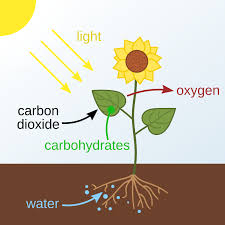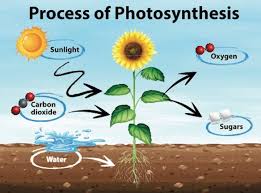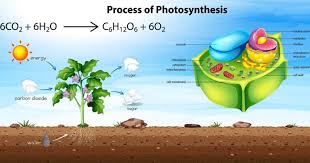Photosynthesis is one of the principal biochemical processes supporting plant growth and development. Because of its basic nature, it is intimately involved in reproductive growth and determining crop yields.
Photosynthesis of a crop canopy can be broken down into three components: leaf area development, photosynthetic rate per leaf area, and partitioning of assimilates between vegetative and reproductive growth, or source-to-sink relationships.
The leaf surface area intercepts solar radiation and enables the photosynthetic conversion of that radiant energy into chemical energy. This production of chemical energy and the subsequent use of that energy to fix CO₂ into photosynthetic carbon assimilates represent the source side of yield development.
Fruiting buds, flowers, and fruit development constitute the reproductive sink side of the yield equation, although other vegetative growing points can act as secondary sinks.
Read Also: 15 Medicinal Health Benefits Of Echinacea purpurea (Purple Coneflower)
Importance of Plants and Photosynthesis in Life and Agriculture

All life on earth depends on plants. Plants are autotrophic, meaning they can convert simple molecules like CO₂ from the atmosphere and minerals from the soil into complex carbohydrates, proteins, and fats, forming the basis of living organisms.
The most important set of chemical reactions in plants harnesses the energy of sunlight in the process of photosynthesis, which generates sugar, oxygen, and a molecule called ATP. ATP is energy in its simplest form and powers the chemical reactions that support life in both plant and animal cells.
The Basics of Photosynthesis in Plant Physiology
Photosynthesis literally means “to put together with light.” All reactions of photosynthesis occur inside chloroplasts. Chloroplasts are small organelles that are green because they contain chlorophyll.
Mesophyll cells in the leaves and stem contain many chloroplasts, each with a highly ordered array of membranes arranged in stacks. These stacks are called thylakoid membranes and function as solar panels with a large surface area that organizes chlorophyll and pigments called carotenoids to collectively absorb and utilize light energy.
Photosynthesis consists of two parts:
1. Light reactions: The light absorption phase of photosynthesis occurs only during the day in the thylakoid membrane. In this reaction, water is split and oxygen is released. More importantly, it provides the chemical energy needed to fix CO₂ into carbohydrates.
2. Carbon reactions (dark reactions): These occur in the matrix of the chloroplast called the stroma and use protein types called enzymes. The most important enzyme is rubisco, the most abundant protein in plants and the major consumer of nitrogen.
This is why plants deficient in nitrogen become unproductive and turn yellow due to reduced photosynthesis. The dark reaction creates three-carbon sugar products that leave the chloroplast for respiration and sucrose synthesis.
The sucrose is converted to starch or transported to other parts of the plant for storage or growth through the phloem.
Read Also: The Health Benefits of Using Accent Seasoning on your Cooking
Factors Affecting Photosynthesis in Plants

1. Temperature: When CO₂, light, and other factors are not limiting, photosynthesis increases with a temperature rise from 6°C to about 37°C. Above this, the rate declines abruptly, and tissue dies at 43°C due to enzyme inactivation. Optimum temperature falls between 20–30°C.
Above this, maximum rate is not maintained due to time effects, and the optimum is reduced from 37°C to 30°C. Under limiting conditions, the rate follows Vant Hoff’s rule, doubling with each 10°C rise, as all Calvin cycle reactions are temperature-dependent and CO₂ diffusion accelerates with temperature.
2. Carbon Dioxide Concentrations: About 0.032% of carbon dioxide is present in the atmosphere, acting as a limiting factor. Under ideal conditions, increasing CO₂ concentration from 0.03% to 0.3–1% boosts photosynthesis.
Beyond this, assimilation rates increase slightly and then plateau. Plants differ in their ability to use high CO₂ levels. For example, in tomatoes, excess CO₂ causes leaf senescence. Historically, CO₂ concentration was as high as 20%.
3. Light: The active light spectrum for photosynthesis ranges from 400–700 nm. Green light (550 nm) is also involved. Light varies in intensity, quality, and duration:
i. Intensity: When other factors are non-limiting, low light intensity increases photosynthesis. Saturation may occur, beyond which further intensity offers no increase. C₃ plants reach saturation at lower light than C₄ plants. Excessive light can cause photo-oxidation, where organs consume O₂ instead of CO₂.
ii. Quality: Action spectrum shows peaks in red and blue regions where chlorophyll absorbs most. Red and blue light favor photosynthesis in green plants, green light suits red algae, and blue light suits brown algae.
iii. Duration: Longer light exposure results in more photosynthesis. Interruption causes CO₂ fixation to cease immediately, as no plant retains significant photochemical products for later use.
4. Oxygen: Oxygen inhibits photosynthesis in C₃ plants but affects C₄ plants less. Reduction of oxygen concentration from 20% to 0.5% can increase photosynthesis by 30–50%. Oxygen promotes rapid respiration, competes with CO₂, and reduces hydrogen instead of CO₂. It also deactivates chlorophyll’s excited state, hindering photosynthesis.
5. Water: Water is essential but only a small fraction is used in photosynthesis. Reduced soil moisture decreases photosynthesis due to protoplasm dehydration and stomatal closure, which limits CO₂ uptake. Dehydration affects the colloidal state of protoplasm, impairs enzymes, and may damage chloroplast structures. It may also dry cell walls, increase respiration, and reduce photosynthesis.
6. Mineral Elements: Elements like Mg, Fe, Cu, Cl, Mn, and P are essential and closely linked to photosynthetic reactions.
7. Air Pollutants: Gaseous and metallic pollutants like ozone, SO₂, oxidants, and fluorides reduce photosynthetic efficiency.
8. Chemical Compounds: Compounds such as HCN and H₂S, even in small amounts, inhibit photosynthesis by affecting enzymes. Chloroform and ether can also temporarily halt photosynthesis.
9. Chlorophyll Contents: Studies show that even with ten times more chlorophyll, a green-leafed barley plant assimilated CO₂ at the same rate as a yellow one. Excess chlorophyll does not mean higher photosynthesis unless supported by enzymes and co-enzymes.
10. Protoplasmic Factor: In addition to chlorophyll, protoplasmic factors influence dark reactions. These factors develop as seedlings mature and are believed to be enzymatic, as high temperatures or strong light destroy photosynthetic ability despite cells remaining green.
11. Accumulation of Carbohydrates: If photosynthates are not transported, they accumulate, increase respiration, and reduce photosynthesis. Excess starch reduces chloroplast efficiency.
Photosynthetic Variations in C₃ and C₄ Plants
Plants are grouped based on how photosynthesis is completed. The dark reactions described earlier are found in over 95% of plants and are typical of C₃ plants.
The continuation of this article should explain the differences in carbon fixation pathways between C₃ and C₄ plants and their implications for crop selection and yield.
Do you have any questions, suggestions, or contributions? If so, please feel free to use the comment box below to share your thoughts. We also encourage you to kindly share this information with others who might benefit from it. Since we can’t reach everyone at once, we truly appreciate your help in spreading the word. Thank you so much for your support and for sharing!

